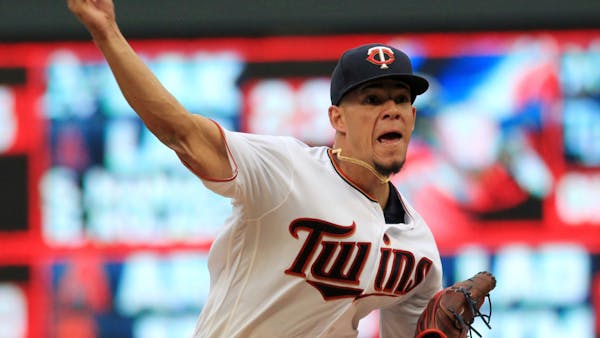Cumulatively, Eddie Rosario has been one of the Twins' best hitters this season. He's second on the team in slugging percentage (.463) and OPS (.788) among regulars (behind Miguel Sano in both cases) and his .284 average leads all Twins hitters.
Rosario has largely put up those numbers, however, at the bottom of the order. Going into Sunday, he had started 91 games for the Twins this season. He had never batted higher than fifth in the order — and he had only risen that high nine times. He hit sixth another 21 times. The other 61 starts? Rosario batted seventh, eighth or ninth.
One could argue that Rosario has flourished because there has been less pressure put on him, that he earned those lower places in the order because of his tendency to be a free swinger and that it's nice to have a dangerous hitter at the bottom of a lineup.
But at a certain point, you also want your best hitters clustered together. To that end, Rosario on Sunday batted cleanup for the Twins in a lineup that has been in search of offense lately. He responded with a game-tying home run in an eventual 6-5 victory over Texas.
One game is a terrible sample size, but Rosario's elevation in the batting order at least leads to this question: Has he earned the right to be a more permanent fixture in the middle of the lineup based on his body of work this season?
I'll admit some bias here since I've been a fan of Rosario since his rookie season. I was willing to overlook his deficiencies — dreadful walk rate and a general philosophy of swinging at everything — because he has incredible hands at the plate and the confidence of a .300 hitter. He had 46 extra-base hits as a rookie n 2015, including a league-best 15 triples.
His deficiencies caught up to him in 2016, however, as pitchers figured out they didn't need to throw him strikes. He was still swinging at everything, and by mid-May he had a .200 batting average and .532 OPS. He was shipped to Class AAA for six weeks, came back and had a very good final three months when he hit .305 with an .812 OPS. That stretch, though, was buoyed by an unsustainable .387 batting average on balls in play. He only took nine walks in the final three months after coming back to the Twins. Rosario was seeing better results, but he hadn't necessarily figured things out.
Fast-forward to this year, though, and we can see more legitimate signs of lasting improvement. His walk rate is still just 5.7 percent (league average is 8.1 percent), but when it was barely 3 percent his first two seasons, it's a start.
Almost as important (if not more so?) Rosario is seeing far more favorable hitting counts this season as a result of his patience. In his first two seasons, a Rosario at-bat reached a 2-0 count less than 11 percent of the time; this season, it's 16.6 percent. He's swinging at fewer pitches this season, and particularly fewer pitches out of the strike zone.
As a result, he's getting better pitches to hit and he's walking at least a little more when he doesn't get pitches to hit. He's striking out once every five plate appearances instead of once every four (as he did the first two years). Rosario's BABIP this season is .328, which is actually a little lower than what it was each of his first two seasons. But he's hitting 15 points higher and he's walking more, pushing an on-base percentage that was below .300 each of his first two years to a more respectable .324 (which is exactly the MLB average).
Rosario probably will never be a guy who walks a lot, but if he can become a guy who walks enough — and sees better pitches as a result of an uptick in patience — he could truly be dangerous and a fixture in the middle of the order for years to come. At the very least, this year's trends are encouraging.
Anze Kopitar scores in overtime, Kings beat Oilers 5-4 in Game 2 to tie series
Thunder's Holmgren bests Pelicans' Valanciunas in center matchup to help OKC take 2-0 lead
AP PHOTOS: Russian kids ride sticks with a horse's head in hobby horsing competition
Defending champion Golden Knights beat Stars 3-1 to take 2-0 series lead home to Vegas

